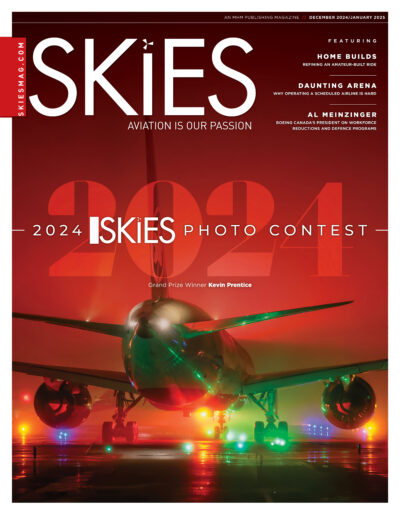EcoPulse, the distributed hybrid-electric propulsion aircraft demonstrator developed jointly by Daher, Safran and Airbus – has concluded its flight test campaign, delivering crucial insights to meet the decarbonization goals for air transport by 2050.
This collaborative project, which is emblematic of the French aerospace sector, has provided unique experience in the design, certification, production, and operation of hybrid-electric aircraft.
Pioneering flight tests
EcoPulse performed its first hybrid-electric test flight on November 29, 2023, from Tarbes–Lourdes–Pyrénées Airport. Since its maiden flight, EcoPulse accumulated 100 flight hours and performed some 50 test flights with the distributed hybrid propulsion system, the last of which took place in July 2024.
These tests enabled the demonstration of unprecedented onboard electric power levels for distributed electric propulsion, with a network voltage of approximately 800 volts DC and a power output of 350 kilowatts.
The flight tests yielded significant findings, including an objective evaluation of hybridization technologies’ maturity, a performance assessment when integrated into the aircraft, and an identification of operational limitations.
For instance, the tests showed that the synchro-phasing of the ePropellers (electric motors) can reduce interior noise. This synchro-phasing is an additional benefit of the innovative flight control computer, primarily designed to manoeuvre the aircraft – substituting traditional control surfaces – by adjusting the distribution of electric power among the ePropellers.
Technological challenges for the future
More broadly, EcoPulse identified key challenges in decarbonizing aviation:
- Electric and hybrid-electric architectures;
- Development of key components: batteries (performance and operational range) and high-voltage management systems (>400 V);
- Pilot assistance with specialized interfaces;
- Demonstration logic for airworthiness;
- Optimization of weight and noise; and
- Skills associated with managing complexity.
The flight test campaign laid the groundwork for compliance documents to meet regulatory requirements for hybrid-electric propulsion flights, establishing the basis for certifying the safety of innovative aircraft configurations.
An exemplary collaboration at the heart of aerospace innovation
The EcoPulse project showcases the strength of high-level cooperation between Daher, Safran, and Airbus. By pooling their expertise and test resources, the partners demonstrated significant synergies between general aviation and commercial aviation.
“We are particularly pleased with the success of the EcoPulse program and its results. This was the first time we tested a complete hybrid-electric propulsion system in flight, and these trials represented a significant milestone in our technology roadmap,” said Eric Dalbiès, senior vice-president, Strategy, and chief technology officer at Safran. “The lessons learned enable us to continue validating decarbonization technologies.”
“EcoPulse has enabled Daher to take a crucial step forward in developing a low-carbon aircraft. This project not only helped us design an operational system for a demonstration prototype but also tackle critical technological hurdles. Thanks to this rich and unprecedented collaboration, we have made significant progress toward hybridization,” emphasized Pascal Laguerre, chief technology officer of Daher.
“This EcoPulse campaign allows us to advance certain hybrid-electric technologies, such as high-voltage batteries, and integrate them into future aircraft, helicopters, and air mobility solutions,” said Jean-Baptiste Manchette, head of Propulsion of Tomorrow at Airbus. “With distributed electric propulsion, we achieved our goal of modeling flight physics and energy management at the aircraft level, key elements for shaping the next generation of aircraft,” he added.
About EcoPulse
EcoPulse is a collaborative project supported by CORAC (the French Civil Aeronautics Research Council) and co-financed by the DGAC (French Civil Aviation Authority) through France Relance and NextGeneration EU.
Unveiled at the 2019 Paris Air Show, EcoPulse is based on a Daher TBM aircraft platform and equipped with six ePropellers (provided by Safran) distributed along its wings.
Its propulsion system integrates two energy sources: a turbogenerator (an electric generator driven by a gas turbine provided by Safran) and a high-voltage battery pack (provided by Airbus).
At the heart of this architecture lies a Power Distribution and Rectification Unit (PDRU), which protects the high-voltage network and distributes available electrical power, along with high-voltage supply harnesses (both provided by Safran). The battery, designed by Airbus, is rated for 800 volts DC and can deliver up to 350 kilowatts of power.
The demonstrator also benefits from the aerodynamic and acoustic integration expertise of the European aircraft manufacturer, with Airbus’ development of the flight control computer enabling aircraft maneuvers via the ePropellers, and synchro-phasing to support future acoustic recommendations for aircraft.
This press release was prepared and distributed by Airbus.
EcoPulse: A milestone toward tomorrow’s low-carbon aviation
With the conclusion of the EcoPulse program, Daher, Safran, and Airbus reaffirm their commitment to sustainable aviation. This pioneering project lays the groundwork for the technological and regulatory advancements needed to address the environmental challenges of future air transport.



What I gather is, the hybrid system mentioned above is like the long-familiar Diesel-electric railroad locomotive principle of a prime mover connected mechanically to a generator or alternator, which in turn provides electric power to multiple traction motors. This works well for locomotives, because mechanical transmission of power from the engine to the drive axles would be too complex and troublesome. But the series-hybrid configuration suffers the disadvantage in that overall efficiency of this arrangement is the product of the efficiencies of the generator/alternator and drive motors. For airplanes, it may be better to use a parallel-hybrid configuration whereby the engine drives the propeller directly, but with an electric machine on the driveline. Said electric machine would function as a motor to assist takeoff, or as a generator to provide for the aircraft’s electric power needs.